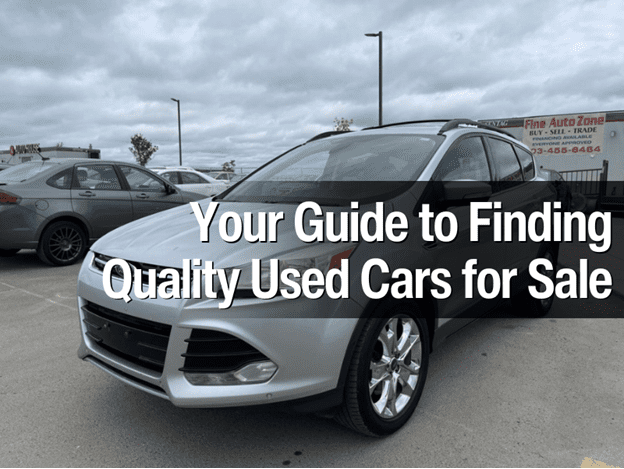
Buying a used car can be a tedious and daunting task at the same time! For most people it is one of the biggest purchases of their lives, therefore caution is advised, especially for pre-owned cars.
Buying a used car is one of the easiest ways to save money. To find the perfect used car, there are certain “golden rules” that must be followed. This guide is designed to help you navigate through the challenges of finding the right car for you. If you follow these steps, the chances of you being stuck with overpriced, unreliable, and unsafe cars are slim.
Step 1: Set Your Budget
It is important to set a realistic budget. It should be exactly how much you can afford and not have to take loans and be under mountains of debt.
Determine how much you can spend, considering your current financial status and after you own a car. Make sure to add these to your list of expenses:
- Insurance: The cost of car insurance depends on the car model, driver, etc.
- Gas money: How much fuel can you afford in your salary? Buy a car that is a fuel sipper.
- Maintenance: oil changes, battery health, tire rotations. Although these are once or twice in 2 months expenses, nevertheless these are present.
Once you are aware of your financial capacity it’s time to move to the next step and find your car model.
Step 2: Distinguish Between Needs and Wants
When buying something new it is easy to go overboard. Therefore, it is important to draw a line between your needs and wants. Be brutally honest with what you need in a car and what you would “want” to have in your car. Focus on your needs and if you get a “want” that’s a bonus!
Be realistic about what you need. Whether you are looking for a family SUV that needs to be spacious and have good boot capacity or you need something for daily commute with low fuel cost and smooth drive.
Remember to not get sidetracked by fancy features that you will probably never use. As soon as you have narrowed down your car models, you need to research the pros and cons of it.
Step 3: Research
This is the most crucial step in your car hunt. Consider the internet your best friend and get started. Use different forums, search on various apps, and watch videos on these car models. You should research about:
- Safety: You shouldn’t ever compromise on safety, so make sure to check safety checks from reputable organizations. Research about crash rating, side impact as well as rollover protection.
- Guides and blogs: look at different blogs, websites, and reviews of owners. They will give you an honest review of the car as they are using it. Look for common problems that can arise, the pros and the cons of your specific models.
- Compare and contrast models: review the comparison between different models of the car, watch videos, and read reviews to make sure you are getting the best value for your money. Compare fuel economy, horsepower, etc.
- Forums: check different forums. Various car communities share their real-life experiences. You will get to know the good and the bad aspects of the car from a real owner. It also gives a complete picture of the car and its performance over the years.
- Resale value: Lastly, make sure to check the resale value of the car, as some cars’ value is depreciating faster than others.
Step 4: Find A Seller
It’s time for the fun and exhausting part of buying a used car. There are two different ways you can find a seller. Let’s look into both ways:
- Dealership: dealerships do give you peace of mind. As they filter through the cars for you. Most of them have been through the process of inspections and warranties. However, this peace comes with added costs. So you are willing to pay a little extra cash. A dealership is a good approach to finding a used car.
- Private sellers: Unlike dealerships, you’ll need to thoroughly check the car yourself. A pre-purchase inspection by a mechanic is strongly recommended. It is possible that you might discover hidden gems – cars that are in exceptional condition. These are often cars with low mileage from families who prioritized maintenance.
Step 5: Find Your Car
Whether you are opting for a dealership or a private seller, the exciting part of buying a car has begun. Look for different cars (of your specific model), and use the internet, newspapers, and local dealerships.
Always remember to meet the seller at a neutral location, if you are going to their home make sure you bring someone with you. Never take the cash with you. Safety should always be prioritized.
Shortlist a few cars, and meet the seller. Assess the car yourself, check for any major/minor accidents, ask the owner for their original documentation, as for any mechanical issues, if any part of the car was replaced, especially the engine, and its documentation.
If you are satisfied with the overall appearance of the car, take it out for a test drive. Check the overall performance, breaks, and steering wheels, is it comfortable? Any noise or vibrations that might be coming from the car.
If the car checks all your boxes it’s time for a pre-purchase inspection from a mechanic. It is an extra step however it smoothes the process of buying a second-hand car. The mechanic would be able to tell if there are any hidden issues.
Step 6: Negotiation
If all goes right, you are in the negotiation phase of buying your new car. There is always some room for negotiation so here is how you can pull it off:
Knowledge: your research is going to help you tremendously in this step. By knowing the selling price that is going around in your area, the quality of features this car has will give you a strong position for bargaining.
Meet at the middle ground: give the owner your quote as well. Make sure it is well within your budget but isn’t too low for the car features as well. Meet at the middle ground from the asking price.
Step 7: Sealing the Deal
Congratulations! You are almost the owner of your new car. Before you get too excited, ensure that you pay through a pay order or bank transfer. It is recommended to not pay in cash. Make sure you have a paper trail to back you with your payment.
Even if the car is in your garage, it is not yours if the name isn’t transferred. Make sure to transfer it to your name, and check for any mechanical work you would need before taking it out for your first ride.
Find the Perfect Used Car
Buying a car is a big decision. However, with proper planning and researching you can find a car that is a perfect fit for you. Remember patience is key so don’t rush the process. Follow these steps, thoroughly inspect the car, confidently negotiate, and secure all the necessary paperwork.
By following this guide, Before you know it, you will be driving your new car. Happy car hunting!




